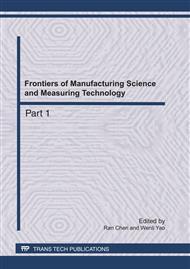p.559
p.564
p.569
p.573
p.578
p.582
p.587
p.592
p.596
Transient Dynamics Simulation of Helical Gear Pair Based on ANSYS
Abstract:
Transient dynamic theory of the helical gear drive is investigated, and corresponding dynamics equations are derived. Based on parameterized language APDL of ANSYS, a parametric programming module for accurate modeling and automatic assembling of helical gear pair has been developed. The parametric modeling and transient dynamic analysis of a helical gear pair in a crane reducer are performed. Transient stresses and strains of the gear pair throughout the engagement process are obtained and the worst meshing location can be determined. Compared to the traditional static analysis, Simulation results of dynamic analysis are more accurate and reliable which provide the foundation for accurate estimation of the gear fatigue life.
Info:
Periodical:
Pages:
578-581
Citation:
Online since:
May 2011
Authors:
Keywords:
Price:
Сopyright:
© 2011 Trans Tech Publications Ltd. All Rights Reserved
Share:
Citation:


